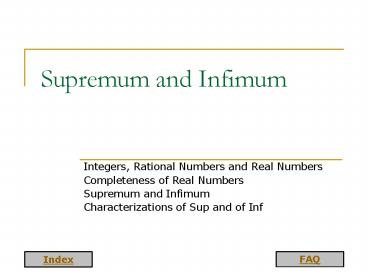Supremum and Infimum - PowerPoint PPT Presentation
1 / 12
Title:
Supremum and Infimum
Description:
A set A need not have neither upper nor lower bounds. The set A is bounded from above if A has a finite upper bound. ... The set A has finite lower bounds. ... – PowerPoint PPT presentation
Number of Views:1451
Avg rating:3.0/5.0
Title: Supremum and Infimum
1
Supremum and Infimum
- Integers, Rational Numbers and Real Numbers
- Completeness of Real Numbers
- Supremum and Infimum
- Characterizations of Sup and of Inf
2
Integers, Rational and Real Numbers
Notations
Natural Numbers
Integers
Rational Numbers
Theorem
There are no rational numbers r such that r22.
Notation
Real Numbers
Real numbers consist of rational and of
irrational numbers.
3
Integers, Rational and Real Numbers
There are not rational numbers r such that
r22.
Theorem
Assume the contrary.
Proof
Then there are positive integers p and q such
that p2/q22 and p and q do not have common
factors.
This means that p22q2.
Hence the area of a square with side length p
is twice the area of the square with side length
q. Furthermore p and q are smallest such
numbers since they do have common factors.
Now p and q are integers so that
Bp22q22G. I.e. the area B of the large brown
square is twice the area G of the green square.
Graphically
4
Integers, Rational and Real Numbers
There are not rational numbers r such that
r22.
Theorem
Furthermore, p and q are smallest integers
such that the area B of the large brown square
is twice the area G of the smaller green square,
B2G.
Proof (contd)
p
q
A
Now move a copy of the green square to the upper
right hand corner of the larger square.
p
I
p-q
A
The intersection I of the two copies of the green
square is the square I with the area I.
q
The two squares marked by A in the picture have
the same area A. Furthermore, by the
assumptions, I2A. This is impossible, since B
and G were the smallest squares with integer
side lengths such that B2G.
5
Upper and Lower Bounds
Let A be a non-empty set of real numbers.
Definition
A set A need not have neither upper nor lower
bounds.
The set A is bounded from above if A has a
finite upper bound.
The set A is bounded from below if A has a
finite lower bound.
The set A is bounded if it has finite upper and
lower bounds.
6
Bounds of Integers, Rationals and Reals
Observations
Any non-empty bounded set of integers has the
largest (and the smallest) element which is also
an integer.
1
2
Consider the set of rational numbers r such
that r2 2.
This means that the set of rational numbers is
not complete in the sense that the set of
rational upper bounds of a bounded set does not
necessarily have the smallest rational upper
bound.
7
Supremum
Completeness of Real Numbers
The set A has finite upper bounds. An
important completeness property of the set of
real numbers is that the set A has a unique
smallest upper bound.
Definition
The smallest upper bound of the set A is called
the supremum of the set A.
sup(A) the supremum of the set A.
Notation
Example
8
Infimum
The set A has finite lower bounds. As in the
case of upper bounds, the set of real numbers is
complete in the sense that the set A has a
unique largest lower bound.
Definition
The largest lower bound of the set A is called
the infimum of the set A.
inf(A) the infimum of the set A.
Notation
Example
9
Characterization of the Supremum (1)
Theorem
Proof
10
Characterization of the Supremum (2)
Theorem
For a non-empty set A
Proof Contd
11
Characterization of the Infimum
Theorem
For a non-empty set A
The proof of this result is a repetition of the
argument the previous proof for the supremum.
12
Usage of the Characterizations
Example
Claim
Proof of the Claim
1
2
1
2
and































